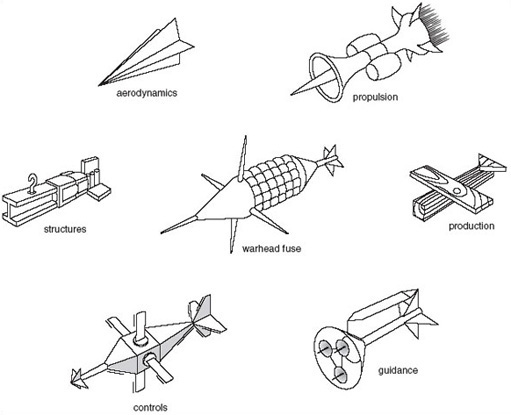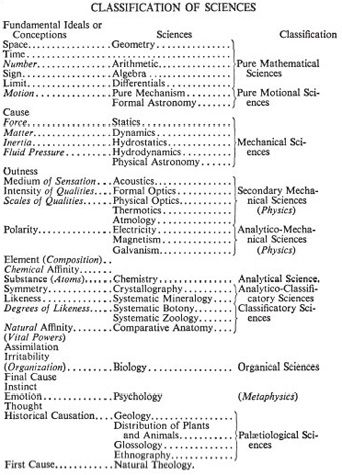3.3 System concepts: holism
One of the distinguishing features of the systems approach is its attempt to be holistic – to include all the elements in the picture at each level at which the system operates. The premature exclusion of important elements can be dangerous and can lead to, for example:
-
a purchasing manager being so keen to drive down raw material and component costs that he or she causes quality and production problems in construction of the system
-
engineers thinking that the design of the control system can be left until later, causing expensive hardware to stand idle waiting for software
-
measures of performance creating an excess inventory and so reducing the cash flow of the system as a whole.
In each case, a proper regard for the wider system – taking a holistic view – would have avoided a sub-optimal course of action. The way that different functional specialists might view the same systems engineering problem is shown in Figure 28.
The systems approach is often contrasted with what is frequently called the ‘reductionist’ approach of traditional science. This characterises science as being concerned with reducing problems to their smallest elements and in doing so to ignore synergistic effects that occur at each level of a deconstruction.

Checkland (1993, pp. 44–58) in particular traces the origins of reductionism back to Descartes’ Second Discourse. In this, Descartes states four rules for developing knowledge:
The first was never to accept anything as true if I had not evident knowledge of its being so; that is, carefully to avoid precipitancy and prejudice, and to embrace in my judgement only what presented itself to my mind so clearly and distinctly that I had no occasion to doubt it.
The second, to divide each problem I examined into as many parts as was feasible, and as was requisite for its better solution.
The third, to direct my thoughts in an orderly way; beginning with the simplest objects, those most apt to be known, and ascending little by little, in steps as it were, to the knowledge of the most complex; and establishing an order in thought even when the objects had no natural priority one to another.
And the last, to make throughout such complete enumerations and such general surveys that I might be sure of leaving nothing out.
(Anscombe and Geach, 1970, pp. 20–21)
This extract suggests that to draw a firm distinction between supposedly reductionist science and a holistic systems approach is too simplistic.
It is the second of Descartes’ rules that is said to sow the seeds of reductionism and the development subsequently of scientific method based on it. However, the characterisation of Descartes’ thinking as reductionist does not accord with the facts. In Rules for the Direction of the Mind, which was written before 1630, and first published in the Opera Posthuma in 1701, Descartes clearly proposes that we should seek to understand what he terms ‘simple natures’, but importantly also that:
… the conjunction of these simple natures with one another is either necessary or contingent. It is necessary when one is implicitly contained in the concept of the other, so that we cannot distinctly conceive of either if we judge that they are separated […] A combination of natures is contingent when they are not conjoined by any inseparable relation; as when we say that a body is animated, a man is clothed, etc.
(Anscombe and Geach, 1970, p. 174)
Descartes is making the point that it is important not only to give attention to individual elements but also to consider how these elements fit together. This is an entirely appropriate position for systems engineering. The whole (system) is understandable only in terms of its components and the proper relationship between them, and the components of a system may have no meaning other than as part of the system.
The desire to separate and classify rather than to regard the natural world as a continuum began in the sixteenth century, gathered momentum during the eighteenth, and reached its apogee in the nineteenth (Foucault, 1974, pp. 125–165). Its origins are to be found in the work of Descartes, Bacon and biologists such as Linnaeus, but the urge to classify quickly spread to related human activities such as the disciplines of science themselves. A classification of the sciences first proposed by the influential Victorian scientist William Whewell in 1840 is shown in Figure 29. In a similar manner, the work of business organisations is routinely divided into functional specialisms such as product development, marketing, operations, and finance. This arrangement, has begun to alter slightly over the past 15 years as the barriers to effective customer focused business that functions represent has been recognised. However, in many, if not most businesses traditional forms of organisation remain dominant.

The logic of such functional specialisation is that it is more efficient. A person, a department, or an organisation that focuses on one area of activity will tend to perform better than others that are ‘jacks of all trades and masters of none’. As Adam Smith famously put it, ‘The division of labour, [however], so far as it can be introduced, occasions, in every art, a proportional increase in the productive powers of labour.’ (Smith, 1976 [1776], p. 9). The systems approach is based upon the alternative and equally important logic that any given circumstance, whether academic or in business, benefits from multidisciplinarity, and when the task is to develop an integrated system that will operate in a closely coupled manner the adoption of a holistic approach is essential.
Holism is of particular importance to systems engineers, as taking a holistic view of a system that is proposed or being developed will help to reduce the potential problems associated with incomplete knowledge, risk and emergence that have been discussed earlier.
